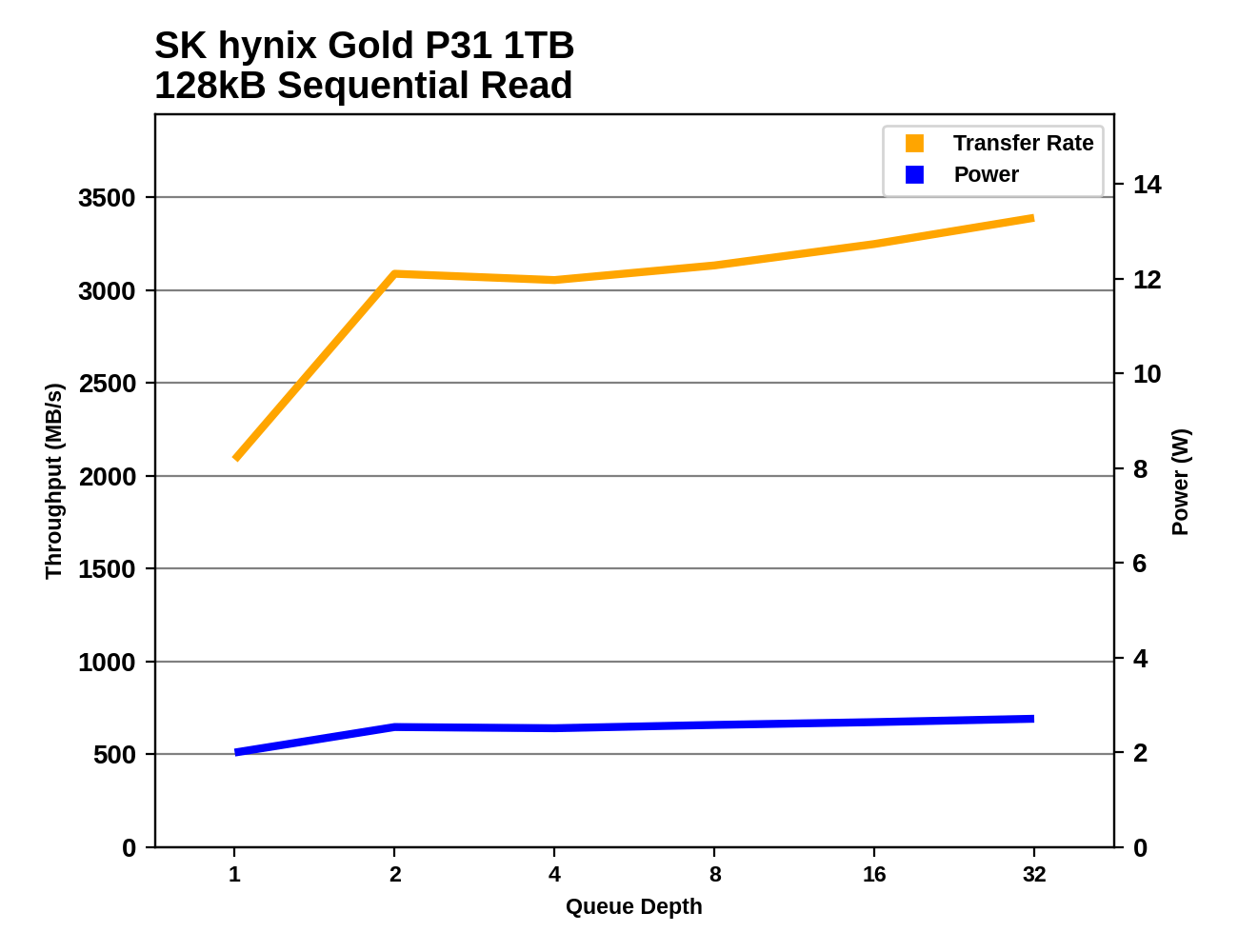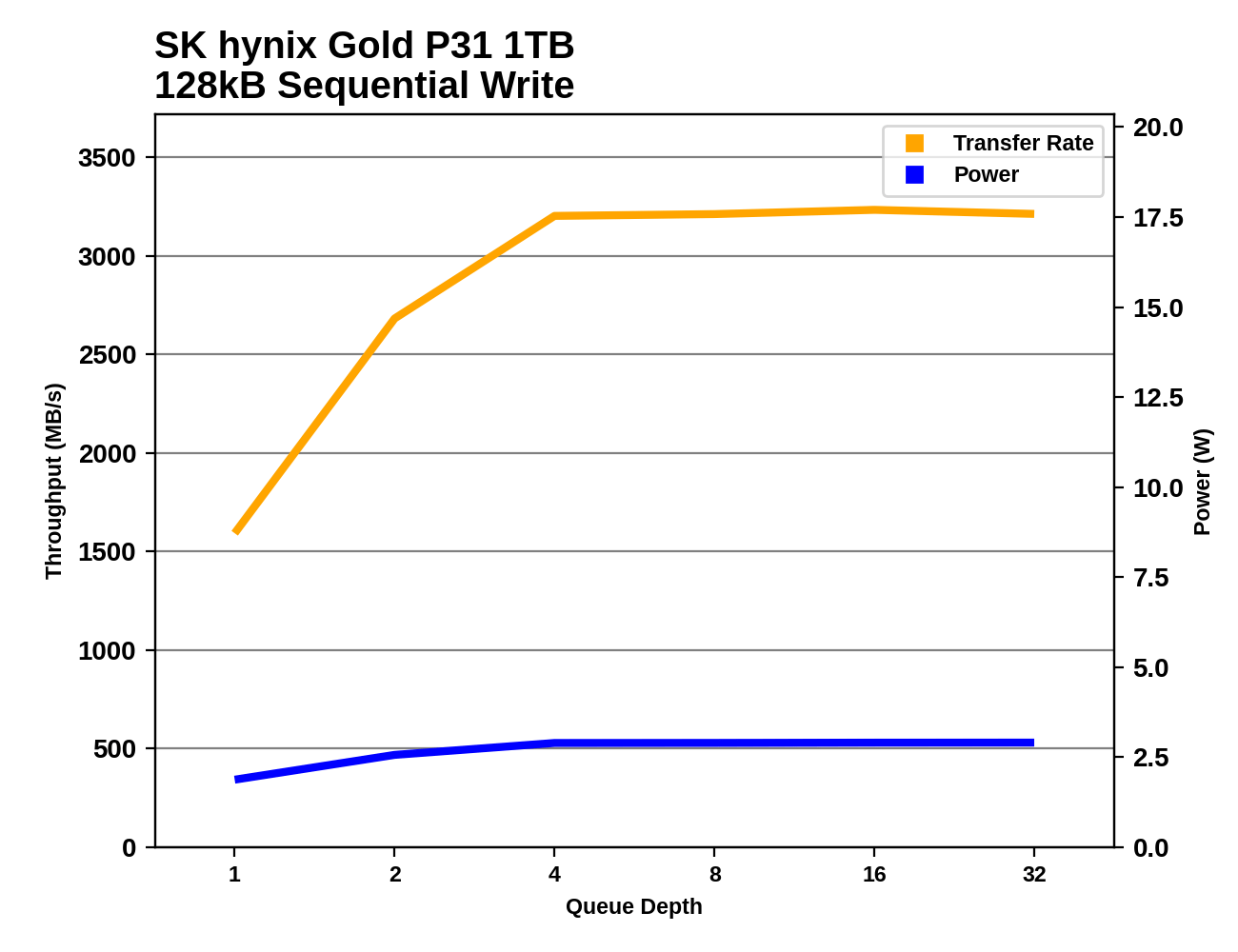The Best NVMe SSD for Laptops and Notebooks: SK hynix Gold P31 1TB SSD Reviewed
by Billy Tallis on August 27, 2020 8:00 AM ESTSequential Read Performance
Our first test of sequential read performance uses short bursts of 128MB, issued as 128kB operations with no queuing. The test averages performance across eight bursts for a total of 1GB of data transferred from a drive containing 16GB of data. Between each burst the drive is given enough idle time to keep the overall duty cycle at 20%.

The burst sequential read performance from the SK hynix Gold P31 is very good, but not quite fast enough to beat the drives based on the Silicon Motion SM2262EN controller.
Our test of sustained sequential reads uses queue depths from 1 to 32, with the performance and power scores computed as the average of QD1, QD2 and QD4. Each queue depth is tested for up to one minute or 32GB transferred, from a drive containing 64GB of data. This test is run twice: once with the drive prepared by sequentially writing the test data, and again after the random write test has mixed things up, causing fragmentation inside the SSD that isn't visible to the OS. These two scores represent the two extremes of how the drive would perform under real-world usage, where wear leveling and modifications to some existing data will create some internal fragmentation that degrades performance, but usually not to the extent shown here.

On the longer sequential read test that involves some slightly higher queue depths, the Gold P31 is basically tied for first place when reading data that was written sequentially. When reading data that has previously been fragmented by the random write test, the P31's performance is considerably higher than the other flash-based SSDs and closer to the Optane 905P.
 |
|||||||||
| Power Efficiency in MB/s/W | Average Power in W | ||||||||
In absolute terms, the power consumption of the Gold P31 isn't drastically lower than some of the other fairly efficient high-end NVMe drives like the WD Black SN750. But once performance is taken into account, the Gold P31's efficiency stands far above the competition.
 |
|||||||||
The SK hynix Gold P31 doesn't need high queue depths to deliver good sequential read throughput: at QD2 it's already above 3 GB/s, but there are further slight performance increases from higher queue depths. That performance profile is very similar to the Samsung 970 EVO Plus, but that drive requires about twice the power that the P31 uses.
Even at QD1, the sequential read performance from the Gold P31 is above the ~2GB/s limit of most other four-channel NVMe drives we've tested (with eg. Silicon Motion SM2263 based controllers). That leaves it entirely in a performance range where all the competitors are 8-channel drives that don't come close to matching power efficiency of the Gold P31.
Sequential Write Performance
Our test of sequential write burst performance is structured identically to the sequential read burst performance test save for the direction of the data transfer. Each burst writes 128MB as 128kB operations issued at QD1, for a total of 1GB of data written to a drive containing 16GB of data.

The SK hynix Gold P31 has fairly ordinary burst sequential write performance by high-end NVMe standards: tied with the SM2262EN-based ATATA SX8200 Pro but beat by the Phison-based Seagate drives.
Our test of sustained sequential writes is structured identically to our sustained sequential read test, save for the direction of the data transfers. Queue depths range from 1 to 32 and each queue depth is tested for up to one minute or 32GB, followed by up to one minute of idle time for the drive to cool off and perform garbage collection. The test is confined to a 64GB span of the drive.

On the longer sequential write test that brings in higher queue depths, the Gold P31 is tied for second place, while the Phison E16 based Seagate drive (built for PCIe 4 speeds, but limited by this testbed to PCIe 3 speeds) unsurprisingly takes first place.
 |
|||||||||
| Power Efficiency in MB/s/W | Average Power in W | ||||||||
At this point, the record-shattering power efficiency scores from the SK hynix Gold P31 are no longer a surprise. The overall fastest drive has the second best efficiency score (56% the performance per Watt of the P31) and the next two most efficient drives are much slower NVMe drives from Toshiba/Kioxia.
 |
|||||||||
The Gold P31 doesn't reach its full sequential write speed until QD4, while several of its competitors saturate at QD2. However, once the P31 is at full speed, it has one of the best sustained write speeds, and shows no sign of its SLC cache running out at any point during the test. Power consumption is comparable to the slowest NVMe drive that can barely hit half the throughput of the Gold P31.
Similar to the sequential read results, the P31 starts out at QD1 with high performance that almost puts it beyond what other 4-channel NVMe drives can do at any queue depth. From there, the P31 continues to redefine what's possible with an increasingly wide lead in power consumption relative to all other high-end drives we've tested.












80 Comments
View All Comments
Srikzquest - Thursday, August 27, 2020 - link
Ok thanks Billy. I am going to get this. I have a 960 EVO in my laptop which I will transfer it to my Desktop (which doesn't use an NVMe SSD currently) and replace that with this in my laptop.lmcd - Thursday, August 27, 2020 - link
Good plan -- make sure though that your laptop mobo supports a new enough NVMe version! 960 was one 1.X release earlier.Billy Tallis - Thursday, August 27, 2020 - link
There are very few ways that NVMe could have trouble with forwards compatibility. I don't think any of them apply to features necessary to boot an OS, or to consumer drives in general. Almost all new stuff in recent NVMe versions has been optional features that your motherboard would never need to use, and your operating system can get by without.vladx - Thursday, August 27, 2020 - link
So most of the newer NVME protocols are enterprise only?Billy Tallis - Thursday, August 27, 2020 - link
It's been a mix of enterprise-only features and embedded-only features. Some of the more enterprise-oriented features would be slightly useful on consumer systems, but only in a world where consumers weren't held back by Windows and its lack of good storage admin tools.lmcd - Thursday, August 27, 2020 - link
I guess 99% of laptops are probably fine but I needed a BIOS update for my Lenovo E485 to accept an EVO 970, afaik. Or maybe I'm mixing it up with my desktop motherboard. All I know is that compatibility hasn't been as consistent as you'd expect.Srikzquest - Friday, August 28, 2020 - link
Thanks Imcd for the headsup as my current laptop is also a Lenovo one, T470. So, I will keep my eyes open.MikeMurphy - Friday, August 28, 2020 - link
I think the low power consumption should also help with thermals, though it's a stretch to think of a typical workload that would keep an NVMe SSD under load for very long.Hul8 - Thursday, August 27, 2020 - link
The ADATA XPG SX8200 Pro 1TB is missing from the list of included comparison drives on page 1.I only noticed because I was disappointed by its omission (I have one), but then found it in the graphs anyways.
Billy Tallis - Thursday, August 27, 2020 - link
Thanks for pointing that out. I've added it to the list on page 1.